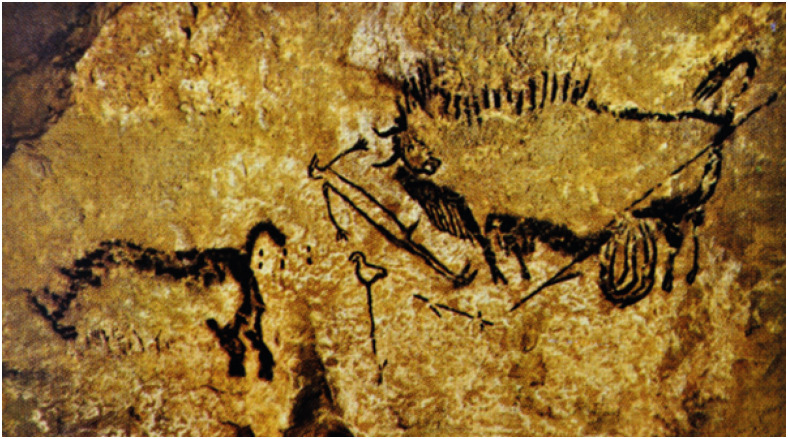In the heart of France, nestled near the southwestern French village of Montignac, Lascaux Cave stands as a silent testament to humanity's ancestral legacy for artful expression. Its walls, adorned with remarkably intricate Paleolithic paintings, provide a window into one of the earliest forms of human storytelling and the creative endeavors of our forebearers.123
Among the cave’s most enigmatic illustrations, the monochromatic “Shaft scene” stands as possibly one of the earliest instances of a hunting scene depicted in European cave art (Fig. 1).24 It features two distinct animals on the cave walls: a rhinoceros on left side and a bison on the right. Between these two animals, a bird-headed human, possibly a shaman, is portrayed in a supine or falling posture. Just below the shamanic figure lies a staff crowned with a bird-shaped motif.
The bison is depicted with a long, unbroken spear penetrating its abdomen from the rear end. Consequently, the bison’s intestines spill out from its gash. Although the bison has been disemboweled, its facial expression implies that the bison is still alive but dying.4 It’s quite fascinating to consider why Paleolithic artists chose to depict the intestines. Were they trying to emphasize the severity of the wound, or could there be some symbolic or divinatory significance attached to the intestines, such as haruspication (entrail-reading)? Regardless of the precise motivation behind this detail, when viewed from a medical standpoint, the cave painting unveils additional layers of significance: these Paleolithic artists, perhaps inadvertently, made the anatomical drawing of the intestines of a mammal.
Unlike the detailed depiction of the bison, the rhinoceros on the left side is portrayed in an incomplete manner, as if the body is undergoing decomposition. In addition, the painting features six dung dots arranged in two rows emanating from its anus.4 The precise reason why the Paleolithic artists chose to depict the rhinoceros and its dung remains elusive. However, considering that defecation is a coordinated physiological process responsible for expelling feces from the digestive tract through the anus,5 this artwork likely represents one of the earliest artistic depictions of mammalian gastrointestinal physiology.
While the Lascaux cave paintings brilliantly showcase human artistic creativity, most of our interpretations still rely on conjecture. However, it is intriguing that these Paleolithic artists, seemingly rooted in mystical or shamanic beliefs, chose to depict anatomy and physiological observations of the gastrointestinal system in their drawings. Coupled with imagination and curiosity, their keen observational and artistic skills likely played a pioneering role in advancing the field of medicine, including gastroenterology.
ACKNOWLEDGMENTS
I am deeply grateful to Professors Jeong Han Kim (Department of Painting, Seoul National University) and Byung Jin Choi (Department of Italian, Hankuk University of Foreign Studies) for helpful discussion and constructive advice.
Notes
References
1. Morriss-Kay GM. The evolution of human artistic creativity. J Anat. 2010; 216(2):158–176. PMID: 19900185.
2. Aubert M, Lebe R, Oktaviana AA, Tang M, Burhan B, Hamrullah , et al. Earliest hunting scene in prehistoric art. Nature. 2019; 576(7787):442–445. PMID: 31827284.
3. Davenport D, Jochim M. The scene in the Shaft at Lascaux. Antiquity. 1988; 62(236):558–562.
4. Maier GJ, Musholt EA, Stava LJ. An interpretation of the famous scene in the shaft in the Lascaux cave and its connection to paintings at the cave entrance. J Transpers Psychol. 2019; 51(2):242–264.
5. Palit S, Lunniss PJ, Scott SM. The physiology of human defecation. Dig Dis Sci. 2012; 57(6):1445–1464. PMID: 22367113.




 PDF
PDF Citation
Citation Print
Print




 XML Download
XML Download